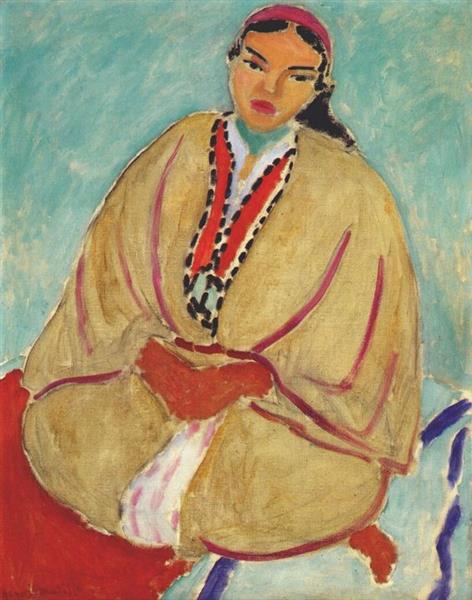Description
Henri Matisse, a giant of modern art and a master of color, presents us in "Zorah in Yellow" a work that encapsulates his ability to fuse form and color in a way that transcends the merely pictorial. Painted in 1912, this piece is an outstanding example of his Moroccan phase, a period during which the artist immersed himself in the cultural and visual richness of North Africa. The work, with its dimensions of 48 x 60, offers a splendor that cannot be ignored.
In "Zorah in Yellow", Matisse presents us with his model, Zorah, wrapped in a vibrant yellow dress that dominates the scene. The color, used boldly and without restrictions, is fundamental to understanding the work. The vibrant yellow of Zorah's dress contrasts with the more muted backgrounds, enriched with geometric and arabesque motifs, which clearly refer us to the aesthetics and decoration of Arab culture. This contrasting use of color underscores the central figure and creates an immediate focus that draws the viewer's gaze.
Zorah's posture is notably static and contemplative, her expression is neutral but full of mystery, which brings an air of dignity and repose to the work. The ornaments that surround her, from the cushions to the upholstered walls, are imbued with repetitive and geometric patterns. These decorative elements not only act as mere backgrounds but also emphasize the cultural connection that Matisse wanted to capture by immersing himself in Moroccan culture.
It is essential to observe how Matisse simplifies forms through his technique. The lines are soft and fluid, without superfluous details, suggesting a synthesis between the human figure and the environment. Instead of seeking anatomical precision or technical virtuosity, Matisse opts for a more emotional and visceral approach, where the intensity of color and the overall composition are the true protagonists.
"Zorah in Yellow" is a celebration of light and color. The yellow, frequently associated with sunlight and vitality, is not a fortuitous choice. Matisse had come to deeply understand the capacity of color to convey sensations and emotions, and in this work, the use of yellow seems to evoke the luminosity and warmth of the Moroccan sun, filling the scene with a vibrant and almost palpable energy.
The work can also be considered within the context of Fauvism, a movement of which Matisse was one of the prominent leaders. The Fauvists were known for their radical use of color, which they used to express feelings in a raw and immediate way, rather than representing the world as they saw it. In "Zorah in Yellow", we can see the culmination of that exploration, where color and form come together to create a profound and evocative visual experience.
This canvas not only captures a moment in time or an exotic portrait; rather, it becomes a cultural bridge, a window into how Matisse perceived and assimilated the world around him. The work resonates with a sense of respect and admiration for different cultures, and through the splendor of colors and the simplicity of forms, Matisse achieves a work of art that is both vibrant and contemplative, modern and timeless.
In conclusion, "Zorah in Yellow" is a testament to Henri Matisse's unparalleled ability to encapsulate and communicate emotions and concepts through color and form. This piece is not only a visual gem but also a profound reflection on the intersection of cultures and the artist's constant quest for beauty and harmony in every stroke and every brushstroke.

